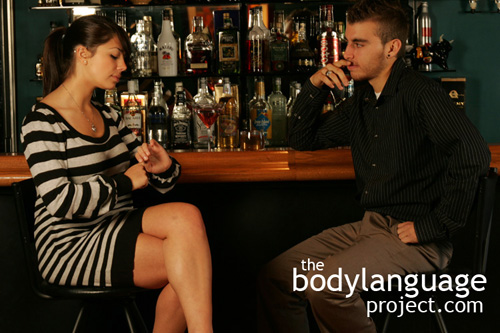Body Language of Upper Lip Smile
Synonym(s): N/A
Description: In this smile, the upper lip is raised to expose only the top row of teeth with the lower teeth remaining hidden and together.
In One Sentence: The upper lip smile indicates insecurity and dishonesty.
How To Use it: This cue is not seen as a positive signal so should be avoided and instead replaced with an honest Duchenne smile or simply a polite smile.
Context: General.
Verbal Translation: “I have a hidden agenda which is why my upper lip raises baring my clenched teeth.”
Variant: See Smiling, Fear Smile, Friendly Smile, Frown (the) or Downturned Smile, Honest Smile or Duchenne Smile, Jaw Drop Smile, Nervous Smile, Polite Smile (the), Uneven Smile Or Lopsided Smile, Upper Lip Smile, Artificial Smile or Fake Smile, Nervous Smile, Honest Smile or Duchenne Smile, Contempt Facial Expression.
Cue In Action: The used car salesman feigned a smile when he saw the customer approaching by only exposing his upper teeth.
Meaning and/or Motivation: The Upper Lip Smile is one that is perceived as insecure and dishonest. People who ‘beam light’ from their teeth in this way will be viewed as having a hidden agenda.
Cue Cluster: Be careful to watch for power plays such as touching, encroaching on personal space and strong eye contact.
Body Language Category: Lying or deceptive body language, Masked emotions.
Resources:
Abel, Ernest L. and Michael L. Kruger. Smile Intensity in Photographs Predicts Longevity. Psychological Science. 2010. 21(4): 542-544.
Centorrino, Samuele ; Djemai, Elodie ; Hopfensitz, Astrid ; Milinski, Manfred ; Seabright, Paul. Honest smiles as a costly signal in social exchange. Behavioral and Brain Sciences. 2010. 33(6): 439-439.
Cashdan, Elizabeth. Smiles, Speech, and Body Posture: How Women and Men Display Sociometric Status and Power. Journal of Nonverbal Behavior. 1998. 22(4): 209-228.
Colonnesi, Cristina; Susan M. Bogels; Wieke de Vente and Mirjana Majdandzic. What Coy Smiles Say About Positive Shyness in Early Infancy. Infancy. 2013. 18(2): 202–220. ISSN: 1525-0008 print / 1532-7078 online
DOI: 10.1111/j.1532-7078.2012.00117.x
http://bodylanguageproject.com/articles/nonverbal-meaning-coy-smiles-infants/
Ekman, P., Davidson, R., & Friesen, W. V. (1990). The Duchenne smile: Emotional expression and brain physiology II. Journal of Personality and Social Psychology, 58, 342–353.
Ekman, P., & Friesen, W. V. (1982). Felt, false and miserable smiles. Journal of Nonverbal Behavior, 6, 238–252.
Ekman, P., Friesen, W. V., & O’Sullivan, M. (1988). Smiles when lying. Journal of Personality and Social Psychology, 54, 414–420.
Ekman, P., Roper, G., & Hager, J. C. (1980). Deliberate facial movement. Child Development, 51, 886–891.
Fairbairn, Catharine E.; Michael A. Sayette; Odd O. Aalen and Arnoldo Frigessi. Alcohol and Emotional Contagion: An Examination of the Spreading of Smiles in Male and Female Drinking Groups. Clinical Psychological Science. 2014. DOI: 2167702614548892
http://bodylanguageproject.com/articles/alcohol-social-lubricant-male-smiles/
Frank, M. G., & Ekman, P. (1993). Not all smiles are created equal: The differences between enjoyment and nonenjoyment smiles. Humor: International Journal of Humor Research, 6, 9–26.
Frank, M. G., Ekman, P., & Friesen, W. V. (1993). Behavioral markers and recognizability of the smile of enjoyment. Journal of Personality and Social Psychology, 64, 83–93.
Grandey, Alicia A. ; Fisk, Glenda M. ; Mattila, Anna S. ; Jansen, Karen J. ; Sideman, Lori A. Is “service with a smile” enough? Authenticity of positive displays during service encounters. Organizational Behavior and Human Decision Processes. 2005. 96(1): 38-55.
Gueguen, Nicolas. Weather and Smiling Contagion: A Quasi Experiment With the Smiling Sunshine. Journal of Nonverbal Behavior. 2013. 37:51–55. DOI 10.1007/s10919-012-0140-y
http://bodylanguageproject.com/articles/weather-smile-not-contagion-smile-linked-weather-conditions/
Golle, Jessika; Fred W.; Mast and Janek S. Lobmaier. Something to Smile About: The Interrelationship Between Attractiveness and Emotional Expression. Cognition and Emotion, 2014. 28:2: 298-310. DOI: 10.1080/02699931.2013.817383.
http://bodylanguageproject.com/articles/smiles-arent-just-cameras/
Guéguen, N. The Effect Of A Woman’s Smile On Men’s Courtship Behavior. Social Behavior and Personality. 2008. 36(9): 1233-1236.
http://bodylanguageproject.com/articles/how-women-can-use-a-simple-smile-to-attract-men/
Guéguen, N., & Fischer-Lokou, J. (2004). Hitchhiker’s Smiles And Receipt Of Help. Psychological Reports. 94: 756-760.
Gosselin, Pierre; Reem Maassarani; Alastair Younger and Mélanie Perron. Children’s Deliberate Control of Facial Action Units Involved in Sad and Happy Expressions. Journal of Nonverbal Behaviour. 2011. 35:225–242. DOI 10.1007/s10919-011-0110-9.
http://bodylanguageproject.com/articles/childrens-control-facial-actions-improve-age-create-accurate-emotional-expressions/
Gunnery, Sarah D.; Judith A. Hall and Mollie A. Ruben. The Deliberate Duchenne Smile: Individual Differences in Expressive Control. Journal of Nonverbal Behavior. 2013. 37:29–41. DOI 10.1007/s10919-012-0139-4
http://bodylanguageproject.com/articles/can-probably-fake-honest-smile-deliberate-duchenne-smile/
Hertenstein, Matthew J.; Carrie A. Hansel; Alissa M. Butts and Sarah N. Hile. Smile Intensity In Photographs Predicts Divorce Later In Life. Motiv Emot. 2009; 33:99-105
DOI 10.1007/s11031-009-9124-6
http://bodylanguageproject.com/articles/small-smiles-predicts-divorce/
Harker, L., & Keltner, D. (2001). Expressions Of Positive Emotion In Women’s College Yearbook Pictures And Their Relationship To Personality And Life Outcomes Across Adulthood. Journal of Personality and Social Psychology, 80(1), 112–124. doi: 10.1037/0022-3514.80.1.112.
Harker, L. A., & Keltner, D. (2001). Expressions of positive emotion in women’s college yearbook pictures and their relationship to personality and life outcomes across adulthood. Journal of Personality and Social Psychology, 80, 112–124.
Johnson, Kareemj. ; Waugh, Christiane. ; Fredrickson, Barbaral. Smile to see the forest: Facially expressed positive emotions broaden cognition. Cognition & Emotion. 2010. 24(2): 299-321.
Johnston, L., Miles, L., & Macrae, C. N. (2010). Why are you smiling at me? Social functions of enjoyment and non-enjoyment smiles. British Journal of Social Psychology, 49, 107–127.
Krumhuber, E., Manstead, A., & Kappas, A. Temporal Aspects of Facial Displays in Person and Expression Perception: The Effects of Smile Dynamics, Head-tilt, and Gender. Journal of Nonverbal Behavior. 2007. 31(1), 39-56.
http://bodylanguageproject.com/articles/slow-onset-smile-best/
Krumhuber, Eva ; Likowski, Katja ; Weyers, Peter. Facial Mimicry of Spontaneous and Deliberate Duchenne and Non-Duchenne Smiles. Journal of Nonverbal Behavior. 2014. 38(1): 1-11.
Krause, Michael W. and Teh-Way David Chen. A Winning Smile? Smile Intensity, Physical Dominance, and Fighter Performance. Emotion. 2013. 13 (2): 270–279. DOI: 10.1037/a0030745
http://bodylanguageproject.com/articles/smile-lose-smile-intensity-predicts-fighting-ability
Krumhuber, Eva G.; Manstead and Antony S. R. Can Duchenne smiles be feigned? New evidence on felt and false smiles. Emotion. 2009. 9 (6): 807-820.
http://bodylanguageproject.com/articles/can-fake-real-smile-practice/
Krumhuber, Eva; Antony S. R.; Manstead; and Arvid Kappas. Temporal Aspects of Facial Displays in Person and Expression Perception: The Effects of Smile Dynamics, Head-tilt, and Gender. Journal Nonverbal Behavior. 2007; 31: 39-56.
http://bodylanguageproject.com/articles/head-tilt-and-slow-onset-smile-nonverbals-trust-attraction-dominance-and-flirting-a-brief-report/
Labroo, Aparna A.; Anirban Mukhopadhyay; Ping Dong. Not Always the Best Medicine: Why Frequent Smiling Can Reduce Wellbeing. Journal of Experimental Social Psychology. 2014. 53:156-162.
http://bodylanguageproject.com/articles/why-too-much-smiling-can-be-bad-for-you/
LaFrance, M. (2002) ‘Smile Boycotts and other Body Politics’, Feminism & Psychology. 12: 319–23.
Lockard, J. S., McVittie, R. I., & Isaac, L. M. (1977). Functional Significance Of The Affiliative Smile. Bulletin of the Psychonomic Society, 9, 367-370.
Lobmaier, Janek S ; Fischer, Martin H. Motivational aspects of recognizing a smile. Behavioral and Brain Sciences. 2010. 33(6): 452-453.
Liu, Chao ; Ge, Yue ; Luo, Wen-bo ; Luo, Yue-jia. Show your teeth or not: The role of the mouth and eyes in smiles and its cross-cultural variations. Behavioral and Brain Sciences. 2010. 33(6): 450-452.
Mehu, Marc ; Grammer, Karl ; Dunbar, Robin I.M. Smiles when sharing. Evolution and Human Behavior. 2007. 28(6): 415-422.
Mehu, M., Little, A. C., & Dunbar, R. I. M. (2007). Duchenne smiles and the perception of generosity and sociability in faces. Journal of Evolutionary Psychology, 5, 133–146.
Otta, E ; Folladore Abrosio, F ; Hoshino, R L. Reading a smiling face: messages conveyed by various forms of smiling. Perceptual and motor skills. 1996. 82(3 Pt 2): 1111-21.
Okubo, Matia; Akihiro, Kobayashi and Kenta Ishikawa. A Fake Smile Thwarts Cheater Detection. Journal of Nonverbal Behaviour. 2012. 36:217–225. DOI 10.1007/s10919-012-0134-9
http://bodylanguageproject.com/articles/fake-till-make-cheaters-fake-smile-make-lies-difficult-detect/
Pease, Barbara and Allan Pease. 2006. The Definitive Book of Body Language Hardcover. Bantam.
Prkachin, Kenneth M. ; Silverman, Barbara E. Stone, Arthur A. (editor) Hostility and Facial Expression in Young Men and Women: Is Social Regulation More Important Than Negative Affect? Health Psychology. 2002. 21(1): 33-39.
Petrican, Raluca; Christopher T. Burris and Morris Moscovitch. Shame, Sexual Compulsivity, and Eroticizing Flirtatious Others: An Experimental Study. Journal of Sex Research. 2015. 52(1), 98–109, 2015. DOI: 10.1080/00224499.2013.829796
http://bodylanguageproject.com/articles/coy-flirtatious-smile-eye-contact-leads-shame-sex/
Quadflieg, Susanne ; Vermeulen, Nicolas ; Rossion, Bruno. Differential Reliance on the Duchenne Marker During Smile Evaluations and Person Judgments. Journal of Nonverbal Behavior. 2013. 37(2): 69-77.
Reed, Lawrence Ian; Katharine N. Zeglen and Karen L. Schmidt. Facial Expressions as Honest Signals of Cooperative Intent in a One-Shot Anonymous Prisoner’s Dilemma Game. Evolution and Human Behavior. 2012. 33: 200-209.
http://bodylanguageproject.com/articles/facial-expressions-honest-signals-smiling-contempt-predict-cooperation-defection/
Reissland, Nadja; Brian Francis, James Mason, Karen Lincoln. Do Facial Expressions Develop before Birth? August 2011. 6(8): e24081. doi:10.1371/journal.pone.0024081.g001
http://bodylanguageproject.com/articles/the-cry-and-laugh-face-in-the-human-fetus/
Seder, J. Patrick and Shigehiro Oishi. Intensity of Smiling in Facebook Photos Predicts Future Life Satisfaction. Social Psychological and Personality Science. 2012. 3(4): 407-413.
http://bodylanguageproject.com/articles/facebook-smile-predicts-life-satisfaction/
Simpson, Elizabeth ; Fragaszy, Dorothy. Can we really leave gender out of it? Individual differences and the Simulation of Smiles model. Behavioral and Brain Sciences. 2010. 33(6): 459-460.
Sauter, Disa A ; Levinson, Stephen C. What’s embodied in a smile? Behavioral and Brain Sciences. 2010. 33(6): 457-458.
Schmidt, K. L., Bhattacharya, S., & Denlinger, R. (2009). Comparison of deliberate and spontaneous facial movement in smiles and eyebrow raises. Journal of Nonverbal Behavior, 33, 35–45.
Surakka, V., & Hietanen, J. K. (1998). Facial and emotional reactions to Duchenne and non-Duchenne smiles. International Journal of Psychophysiology, 29, 23–33.
Samuele Centorrino, Elodie Djemai, Astrid Hopfensitz, Manfred Milinski, Paul Seabright. Honest Signaling in Trust Interactions: Smiles Rated as Genuine Induce Trust and Signal Higher Earning Opportunities. Evolution and Human Behavior DOI:
dx.doi.org/10.1016/j.evolhumbehav.2014.08.001.
http://bodylanguageproject.com/articles/smile-great-gain-smiling-key-negotiation/
Tidd, K., & Lockard, J. (1978). Monetary Significance Of The Affiliative Smile: A Case For Reciprocal Altruism. Bulletin of the Psychonomic Society, 11, 344-346.
Thibault, Pascal ; Gosselin, Pierre ; Brunel, Marie – Lise ; Hess, Ursula. Children’s and Adolescents’ Perception of the Authenticity of Smiles. Journal of Experimental Child Psychology. 2009. 102(3): 360-367.
Vazire, S., Naumann, L.P., Rentfrow, P. J., and Gosling, S. D. (2009). Smiling reflects different emotions in men and women. Behavioral and Brain Sciences, 32:5, 403–405.
http://bodylanguageproject.com/articles/smiling-reflects-different-emotions-men-women/
Vigil, J. M. (2009). A socio-relational framework of sex differences in the expression of emotion. Behavioral and Brain Sciences, 32, 375–428.
Walsh, D. G., & Hewitt, J. (1985). Giving Men The Come-On: Effect Of Eye Contact And Smiling In A Bar Environment. Perceptual and Motor Skills, 61, 873-874.







